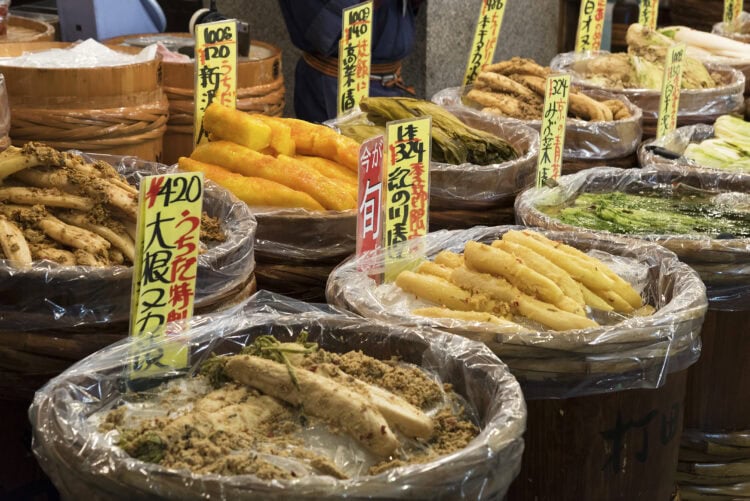Tsukemono, or Japanese pickles (漬物), are essential in Japanese cuisine, accompanying almost all traditional meals with rice and miso soup. They are prized for their distinctive flavors and frequently serve as a garnish, condiment, palate cleanser, or digestive aid.
It’s worth noting that contrary to the idea conveyed by some bloggers, tsukemono is a generic term referring to all these Japanese macerated/fermented vegetables, not a specific dish.
Tsukemono appeared very early in Japanese history, at a time when refrigerators did not exist and pickling was used to preserve food.
As a result, some types of traditionally prepared pickles can be preserved almost indefinitely. The different methods used to make tsukemono range from simple salting or brining in vinegar to more complex processes involving cultivated molds and fermentation.
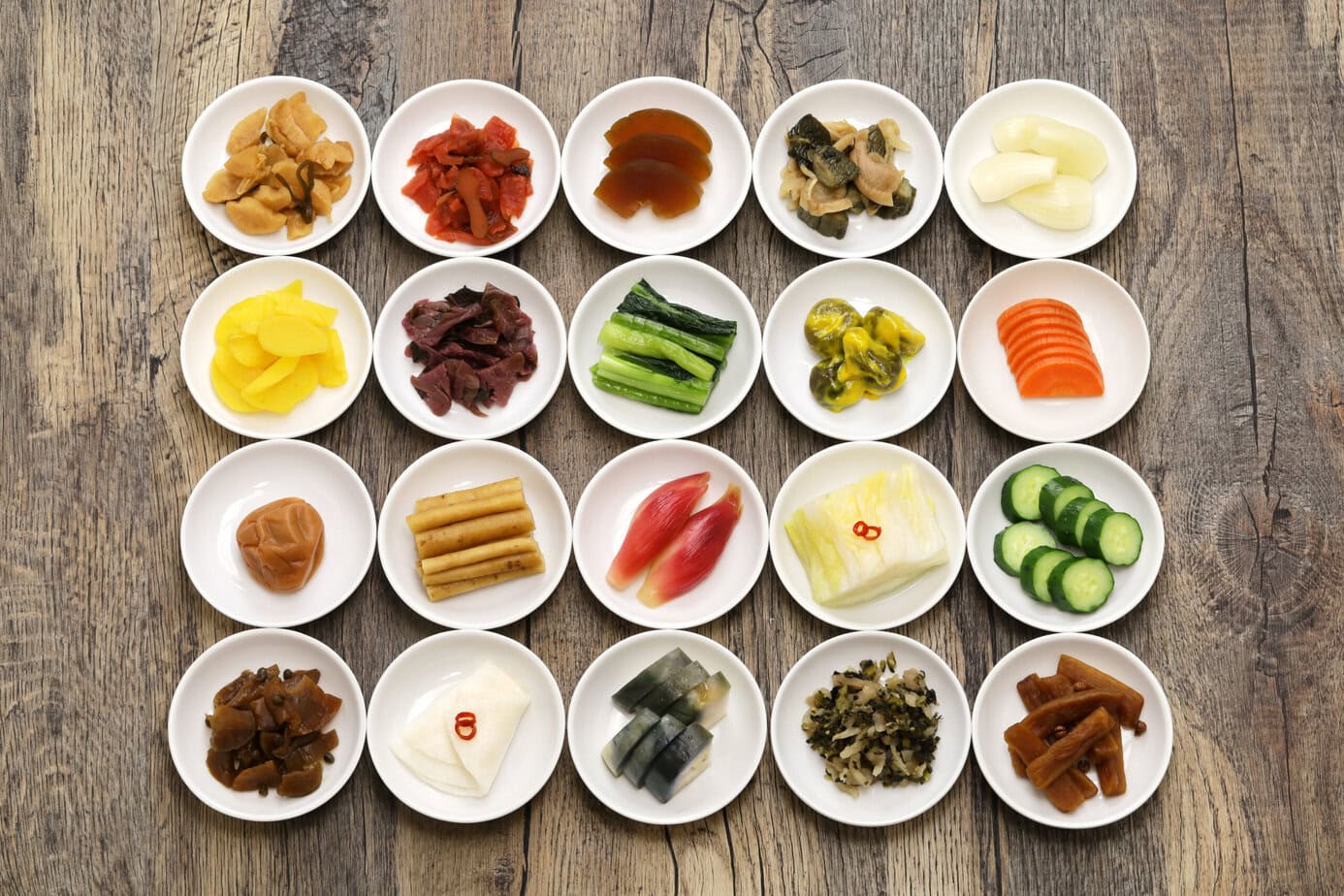
All sorts of vegetables and even some fruits are used to prepare tsukemono, including Japanese radish (daikon), cucumber, eggplant, carrot, cabbage, lotus root, ginger, shallots, and plums (ume).
Sometimes, seaweed and other seafood are added to pickle mixtures to vary the flavors. Some pickling techniques are also used to preserve and flavor seafood and meat dishes.
Basic Generic Technique for Preparing Tsukemono
To prepare tsukemono, start by choosing fresh, seasonal vegetables like daikon radish, cucumber, eggplant, carrot, cabbage, or lotus root. Thoroughly wash the vegetables and cut them into slices, pieces, or sticks according to the specific recipe or your personal preferences. Once the vegetables are ready, place them in a bowl and generously sprinkle them with salt, usually about 2 to 3% of the vegetables’ weight. Gently massage the vegetables with the salt to coat them evenly. This step helps extract water from the vegetables and soften them.
Next, transfer the salted vegetables to a container or resealable plastic bag. Place a weight on the vegetables, such as a plate with a weight or a bowl filled with water, to apply pressure. Personally, I vacuum seal them. Let the vegetables rest for several hours, or even overnight. This step allows the vegetables to release their water and absorb the salt, transforming them into pickles.
After the resting time, quickly rinse the vegetables to remove excess salt and drain them well. You can now add additional seasonings according to your taste, such as vinegar, sugar, konbu, or chili pepper, to vary the flavors. Finally, your tsukemono are ready to be enjoyed. They can be consumed immediately or stored in the refrigerator to be savored later.
The Different Types of Tsukemono
Salt (Shiozuke)
Salt pickles, or shiozuke, are the simplest and most common types of pickles. The most basic ones consist simply of lightly salted sliced vegetables, resulting in pickles with a crunchy texture and a mild fresh vegetable flavor (usually seasonal). See, for example, the Japanese cabbage salad
Heavily salted pickles, on the other hand, are more complex to prepare and have strong, complex flavors. Among these are pickled Japanese plums (umeboshi), often used to flavor onigiri.
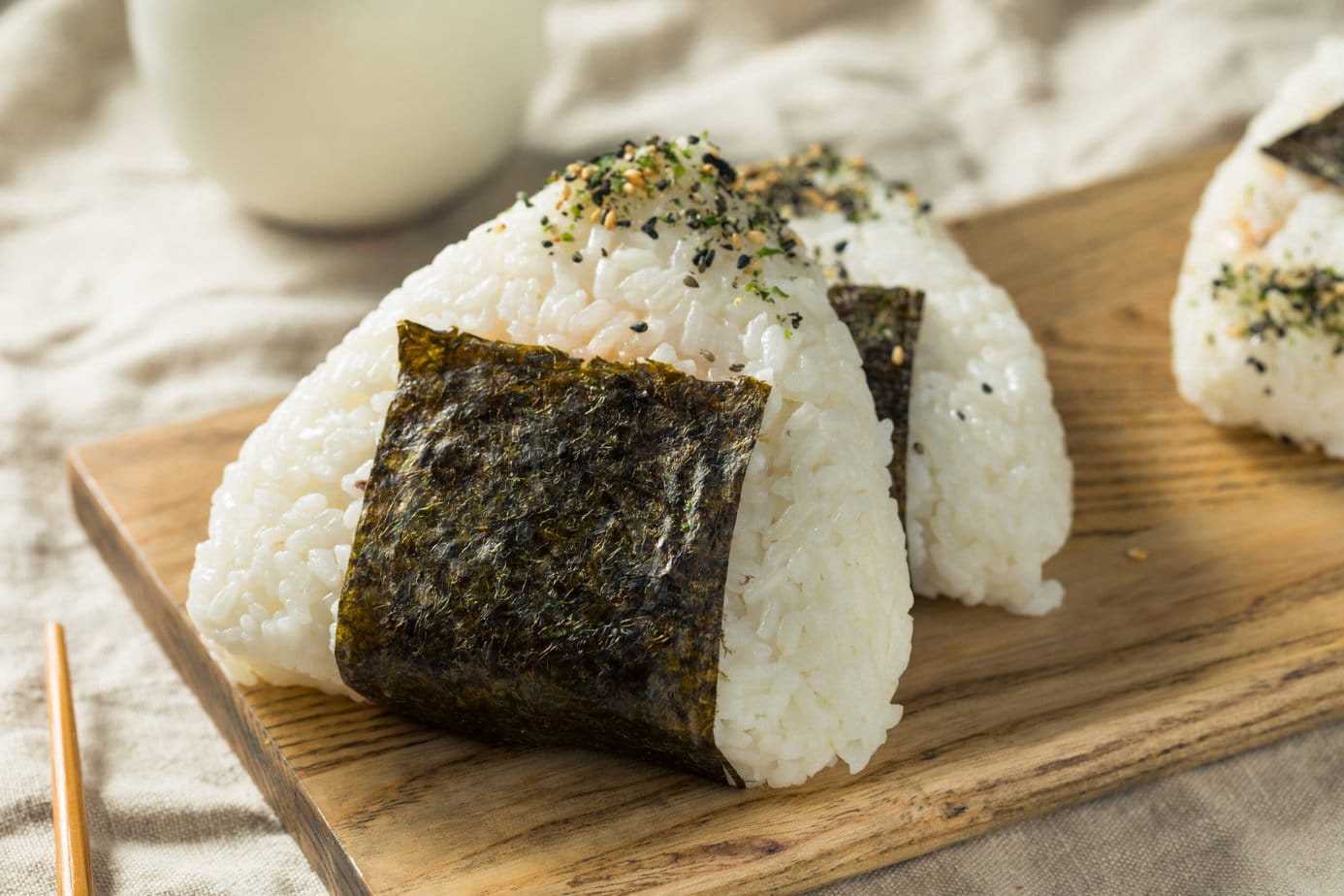
Rice Bran (Nukazuke)
Nukazuke are pickles fermented in a mixture of roasted rice bran (the hard outer layer of rice that is removed during grain polishing), salt, konbu, and other ingredients. Whole vegetables are mixed into the paste and left to mature for a few days to several months.
The resulting pickles, crunchy, salty, and tangy, are then rinsed, sliced, and served. Nukazuke are rich in lactobacilli and are believed to aid digestion.
Sake Lees (Kasuzuke)
Kasuzuke are pickles classified as imperishable, preserved in a mixture of sake lees (the yeast paste that remains after sake filtration), salt, sugar, and mirin. They are left to mature for several days to several years, and the resulting pickles can be slightly alcoholic with flavors ranging from mild and light to strong and pungent depending on the maturation period.
Soy Sauce (Shoyuzuke)
Shoyuzuke are pickles preserved in a soy sauce base. This method produces a wide range of pickles with flavors ranging from light and crunchy to dark brown, salty and sweet toppings such as fukujinzuke. Note that shoyuzuke is a preservation method different from tsukudani, which are foods preserved by cooking them in soy sauce and mirin.
Vinegar (Suzuke)
Pickles marinated in vinegar are known as suzuke. Rice vinegar is commonly used as a pickling agent and gives the pickles a crunchy texture and a sweet and tangy flavor. However, rice vinegar has low acidity and suzuke pickles do not keep long without refrigeration.
Miso (Misozuke)
Similar to nukazuke, misozuke pickles are made by covering vegetables with miso, a fermented soybean paste. These types of pickles tend to be crunchy with a salty miso flavor.
Misozuke and nukazuke are made from similar vegetables, such as cucumbers, carrots, and eggplants, and it can be difficult to distinguish between the two types of pickles by appearance alone. Misozuke is also a popular method for preserving and marinating meat and fish.
The Most Common Tsukemono
If you travel to Japan, here are some Tsukemono you will likely encounter. Most can be found nationwide, unless otherwise indicated, however, the exact ingredients of each dish may vary from region to region and from household to household.
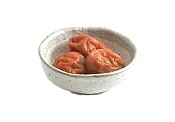
Umeboshi
A classic Japanese delicacy, umeboshi are pickled plums produced by salting and drying fruits that resemble apricots. Their wrinkled red exterior conceals a powerful burst of briny tang, with some variants offering a softer flavor. Valued both as a natural preservative and a digestive aid, they frequently accompany rice—whether in bento boxes or atop onigiri.
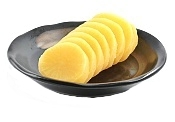
Takuan
Crafted from daikon radish, Takuan is prepared by first drying the radish under the sun before immersing it in a blend of salt, rice bran, and sugar. The outcome is a crunchy pickle with a delicate sweetness, which can range in color from a soft, brownish tone to a bright yellow. In some areas, such as Akita, a smoked variant known as iburigakko is especially prized.
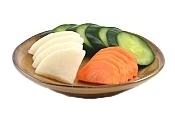
Nukazuke
Nukazuke involves a variety of vegetables—such as cucumbers, carrots, eggplant, daikon, or turnips—that are fermented in rice bran. These robust pickles are a common fixture at set meals and traditional Japanese dining, imparting a distinctive tang that enlivens the overall meal.
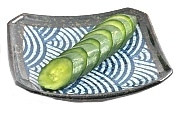
Kyuri Asazuke
These cucumbers are quickly pickled in a straightforward salty brine, occasionally accented with ingredients like kelp, chili, or vinegar. Often served whole on a stick, they are a refreshing street snack, especially popular during the warm months when a crisp bite is most welcome.
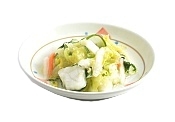
Hakusai no Sokusekizuke
This quick-pickle technique transforms fresh hakusai cabbage into a crisp, lightly salted treat, often combined with carrots and cucumbers. Enhanced with subtle notes of yuzu, kelp, and a sprinkle of chili, it delivers a zesty, citrus-infused bite that is a kitchen staple in Japan.
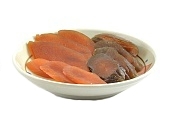
Narazuke
Named after its region of origin, Narazuke are pickles that undergo long-term aging, resulting in a deep, dark color. Vegetables like daikon, melon, or cucumber are immersed in sake lees for several years, producing an assertive, tangy flavor with a hint of alcoholic warmth.
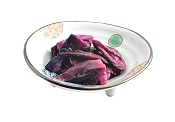
Shibazuke
A hallmark of Kyoto cuisine, Shibazuke is a colorful mix of cucumber, eggplant, perilla leaves, ginger, and myoga, all marinated in plum vinegar—a byproduct of umeboshi making. The resulting purple pickles offer a well-rounded flavor that balances saltiness with a touch of sourness.
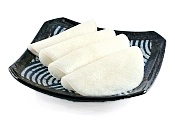
Senmaizuke
Another Kyoto specialty, Senmaizuke is made from ultra-thin slices of turnip that have been pickled in a sweet vinegar blend infused with kelp and chili. Known as the “thousand-layer pickle,” its delicate texture and balanced tang make it a delightful addition to any meal.
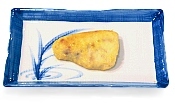
Saikyozuke
Translated as “West Kyoto Pickle,” Saikyozuke features slices of white fish—often cod or halibut—bathed in a rich miso marinade. After marination, the fish is grilled or braised to perfection, resulting in a tender dish with a sweet, caramelized nuance that can be enjoyed warm or at room temperature.
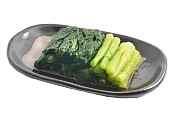
Nozawana
Originating from Nozawa Onsen in Nagano, Nozawana are pickled turnip greens that have been dried and then steeped in a brine spiked with chili and wasabi. Whether chopped finely or served as bite-sized pieces, they offer a lively blend of spice and salt that enlivens many dishes.
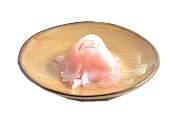
Matsumaezuke
From the town of Matsumae in Hokkaido comes Matsumaezuke—a complex pickle that melds regional ingredients like squid, sea kelp, herring roe, and carrots. Marinated in a mix of sake, soy sauce, and mirin, it delivers a savory-sweet flavor that has won admirers nationwide.
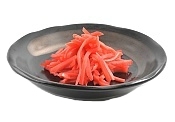
Gari
Widely recognized as the pickled ginger served with sushi, Gari consists of ultra-thin slices that offer a subtle interplay of sweetness, tang, and a hint of spice. Its refreshing properties make it ideal for cleansing the palate between bites, and while it naturally appears pale yellow, some versions may carry a delicate pink tint.

Beni Shoga
Beni Shoga is made from young ginger cut into fine matchsticks and pickled in plum vinegar—a derivative of the umeboshi process. The result is a vividly red condiment with a robust salty and spicy kick, perfect for enhancing dishes like gyudon, takoyaki, and yakisoba.
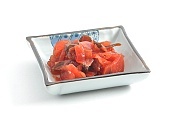
Fukujinzuke
This vibrant medley combines vegetables such as daikon, lotus root, cucumber, and eggplant that have been pickled in a savory-sweet sauce made from soy and mirin. The resulting condiment, with its rich brown or red hue, is a traditional topping for Japanese curry, offering a unique contrast of flavors.

Rakkyo
Rakkyo are delicate, sweet pickled shallots that add a refreshing crunch to Japanese curry. Their subtle sweetness and crisp texture serve as the perfect counterbalance to the rich, spicy flavors of the dish.
